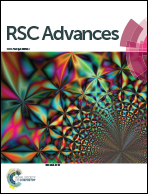Electrodeposition of nickel nanoflowers on screen-printed electrodes and their application to non-enzymatic determination of sugars†
Abstract
In this work, the electrodeposition of nickel on screen-printed carbon electrodes was carried out. As the main novelty, a galvanostatic electrodeposition methodology (application of a constant current for a specific time) was chosen to perform the electrodeposition from a Ni(II) solution. Interestingly, these conditions were able to generate nickel nanoflowers of 160 nm all over the surface. The nickel nanoflowers showed a great electrocatalytic effect towards the oxidation of reducing sugars. After the characterization of the electrode surface and the optimization of the experimental conditions, the non-enzymatic electrochemical device was employed for the determination of reducing sugars. A linear range of 25–1000 μM was obtained, showing good performance for the determination of sugars at low concentrations. The reproducibility was 5.5% (intraelectrode) and 6.9% (interelectrode), indicating a high precision using the same or different devices. After fabrication, the electrode is stable at least for 35 days, even using the same device to carry out measurements on different days. Real food samples such as honey and orange juice were also evaluated with the nickel nanoflower electrochemical device.



 Please wait while we load your content...
Please wait while we load your content...